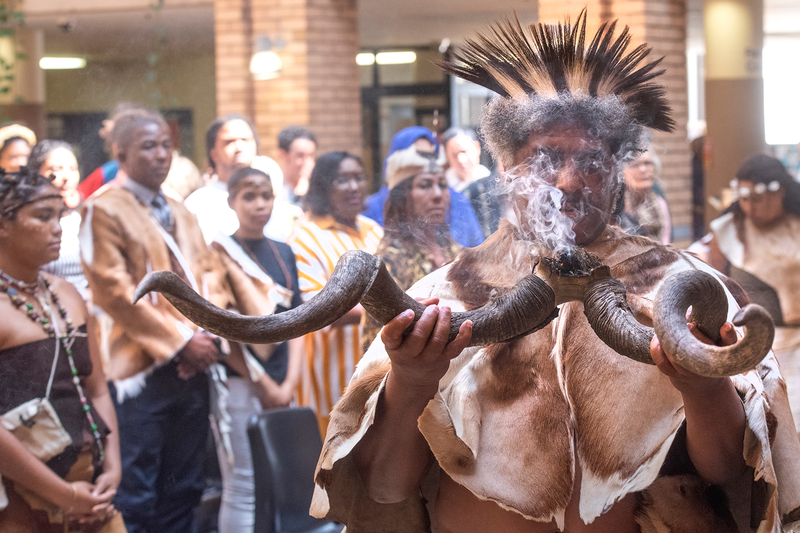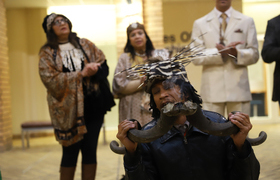UCT launches milestone Khoi and San Centre
23 September 2020 | Story Helen Swingler. Photo Brenton Geach. Read time >10 min.
The University of Cape Town (UCT), situated on land below Huri ǂoaxa (Hoerikwaggo or the mountain in the sea) that was once home to the Khoi and San, marked a milestone on its transformation journey with the launch of the Khoi and San Centre on 21 September.
The centre will foreground erased or marginalised indigenous knowledge, rituals, language and “ways of knowing” of the San and Khoi clans across the university and its communities. Many of their descendants still live in communities across the Cape Flats – and many are students, staff and graduates of the university.
A highlight of the launch was the announcement that an undergraduate programme offering Khoekhoegowab would be developed at UCT in the next five years.
The new centre was launched virtually by Vice-Chancellor Professor Mamokgethi Phakeng via a Summer School webinar titled Knowing on the wind – #oaba #ans. The host was the deputy vice-chancellor for transformation, Professor Loretta Feris. Guest speakers were UCT’s Dr June Bam-Hutchison of the Centre for African Studies (CAS), the new centre’s home, and Tauriq Jenkins, the chairperson of the A/Xarra Restorative Justice Forum at CAS.
Funding came from the Mauerberger Foundation Fund; the Western Cape’s Department of Cultural Affairs and Sport; the national Department of Sports, Arts and Culture; the Community Chest of the Western Cape; and the National Heritage Council of South Africa.
Extensive work
Bam-Hutchison and Jenkins worked jointly over several years to develop and guide the centre to culmination. Bam-Hutchison has worked extensively in indigenous heritage. An internationally known scholar, she co-founded the global !Gâ re – Rangatiratanga – Dadirri project. Her work won the UNESCO Prize for Peace Education for South Africa in 2008. Her maternal line was of the last speakers of the erased Khoekhoegowab in the region.
Jenkins is an accredited South African Human Rights Commission monitor reporting on COVID-19 lockdown violations. He is an alumnus of Columbia’s School of International and Public Affairs International Fellows Program and the high commissioner of the Goringhaicona Khoi Khoin Indigenous Traditional Council.
The A/Xarra Restorative Justice Forum is a unique consultative body at CAS and an exemplar for decolonised participatory structures of traditional indigenous and wide civic representation, focused on meaningful transformation at the university, nationally and globally.
In January this year the forum held its first National Institute for the Humanities and Social Sciences-funded precolonial catalytic conference in partnership with Emeritus Professor Lungisile Ntsebeza (who holds the AC Jordan Chair in African Studies in CAS). Their work at the new centre will take the form of research commissions on language, sacred human remains, land and gender. The centre will support and consolidate this collaborative work.
Speaking at the launch, the vice-chancellor said that the new centre aims to become the foremost research centre of its kind, producing research of international standing and developing bespoke African philosophies and epistemologies through socially engaged research partnerships in San and Khoi studies.
It will also develop a San and Khoi digital archive based on South African minoritised languages and host research fellows and visiting fellows to grow a strong cohort of PhDs in the field.
Footsteps that echo
The launch was a moment to spiritually honour those whose ancestral land UCT occupies, Phakeng added.
“Their spiritual footsteps echo loudly through time in the caves of these mountains. Their knowledges reside deeply in the erased landscape and surrounding fynbos. This part of history was never part of the country’s narrative during apartheid.
“In fact, the entire precinct that the university occupies today, including all its campuses and, among others, the banks of the Liesbeek River, the location of the South African Astronomical Observatory and Valkenberg Hospital, the [Protea Hotel] Breakwater Lodge, Kirstenbosch gardens [and] the Rustenburg slave burial sites was once San and Khoi land. This fact is well documented in the colonial archives.”
Launching the centre in Heritage Month celebrated the diversity of African cultures at Africa’s leading university. Phakeng said that had it not been for COVID-19, the event would have been hosted in UCT’s Sarah Baartman Hall, formerly the Jameson Memorial Hall, which was renamed almost two years ago to acknowledge this history.
Transformation and Vision 2030
The establishment of the new centre is also in step with UCT’s new institutional strategy, Vision 2030, with transformation at its core, Phakeng said.
“Vision 2030 challenges UCT’s colonial and apartheid history by affirming UCT’s African identity, reclaiming African agency and committing to the future of the continent as a global African university.
“So this new centre will become a permanent feature at UCT with a regular celebratory public arts and culture programme, including the hosting of exhibitions, ritual programmes, webinars, conferences, seminars and a host of other diverse cultural events to restore what was once the life of their ancestors who lived on the slopes of these mountains. So, as we meet today, we honour them and ask for their blessing.”
She continued: “We are too familiar with how [the] brutal and painful processes of [the] disposal [and] dispossession of indigenous land led to the erasure of indigenous knowledge, African languages, sacred spaces and practices, and African philosophies of knowing and culture.
“Today, the descendants of these indigenous inhabitants of the land on which the university stands are spread in often abject poverty across the Cape Flats and beyond. This is the painful truth of the deep architecture of our university, which we recognise today with the humility and respect it deserves.
“We want to engage in deep listening as we work in partnership with the San and Khoi descendant communities. We know that this is not a once-off moment but rather a continual journey of recognition and acknowledgement.”
Long time coming
The development continues many years of groundwork by academics such as Bam-Hutchison. Last year UCT held its maiden Khoekhoegowab language short course, a partnership between CAS and the Centre for Extra-Mural Studies. With only 167 000 speakers remaining, Khoekhoegowab is one of the continent’s endangered indigenous languages.
Four 12-week courses were convened by the A/Xarra Restorative Justice Forum and CAS, supported by UCT’s Multilingualism Education Project. It was the first of its kind for a South African university.
Phakeng said: “The achievements of this course were phenomenal. Some 50% were community members who registered and completed the course [for] free.”
The good news is that this course will underpin the development of an undergraduate degree programme over the next five years, Phakeng said.
And last year UCT embarked on another groundbreaking initiative – the Sutherland Reburial Project – with the Department of Human Biology in the Faculty of Health Sciences. This involved the remains of 11 San and Khoi people that were found to have been unethically obtained by the university in the 1920s. The human remains will be reburied at a date yet to be determined. The project was an opportunity for UCT to provide an ethical model of redress and social justice through science.
Collaboration and co-design
Phakeng said that it was important that people like Bam-Hutchison, with her extensive work in indigenous heritage, continue to lead this initiative. The development is built on a long tradition of community engagement at CAS.
“You need someone who understands why it is important. But you also need someone who’s connected to it,” said Phakeng.
Bam-Hutchison said that she was delighted that the archives – the languages, knowledge and rituals – of those who once lived on the slopes of the mountain were now being made visible through the centre.
“It is almost unthinkable that these things have now been moved to [the] centre at the historically white university associated so much with colonialism and those deep wounds of the past.”
This was apparent even in more recent history: the Rhodes Must Fall movement. Students asked about the heritage of the mountain and land that UCT occupies and [why] an ecology of knowledges across the disciplines and the faculties at the university had been marginalised.
“This process culminated in the consultation on the renaming of Jameson Hall to Sarah Baartman Hall, which was a very exciting, very intense, very historic process. But [we’re] also looking at it not only as a metaphor, but what that means in terms of transformation at all levels: teaching, learning, research and even our relationships with communities, staff and workers,” said Bam-Hutchison.
In foregrounding the Khoekhoegowab language, Bam-Hutchison said that they were also mindful of all the other marginalised Southern African languages and the “entanglement within the Khoi and San archive of knowledges and multilingualism and languages”.
The centre also acknowledges the importance of adding to a global body of work in the indigenous languages, those of other first-nation groups in New Zealand, Australia, Canada, etc.
To that end the new centre will work with the Worldwide Universities Network.
Promise of restoration
Jenkins reminded the audience that the Sarah Baartman renaming process came with a promise.
“It is a very strong commitment that it is not just simply changing a sign to another sign. What underpins this is the genuine and sincere continuing struggle of beginning to truly unpack the complexities of the wrongs of the past, but also begin[ning] to uncover a narrative that reveals us as South Africans.”
He said that Thabo Mbeki’s “I am an African” speech on the eve of the announcement of the South African Constitution in 1996 mentioned the Khoi and the San.
“At that stage, there were aspects that were not there but are here now. Here we have the establishment of the Khoi and San Centre. We have a renaming of Jameson Hall. Khoekhoegowab as a language has found its way back to the Western Cape. And, to some degree, Khoi and San have been recognised in the Constitution.
“And so, we’re moving very close to rekindling our own fullness of the African body. In many ways the African Renaissance would have remained at the nascent stage until this fuller recognition had come about. This is part of a missing cog, which is moving its way back into the centre – a recognition of what had been lost and needs to be rejuvenated.”
 This work is licensed under a Creative Commons Attribution-NoDerivatives 4.0 International License.
This work is licensed under a Creative Commons Attribution-NoDerivatives 4.0 International License.
Please view the republishing articles page for more information.










